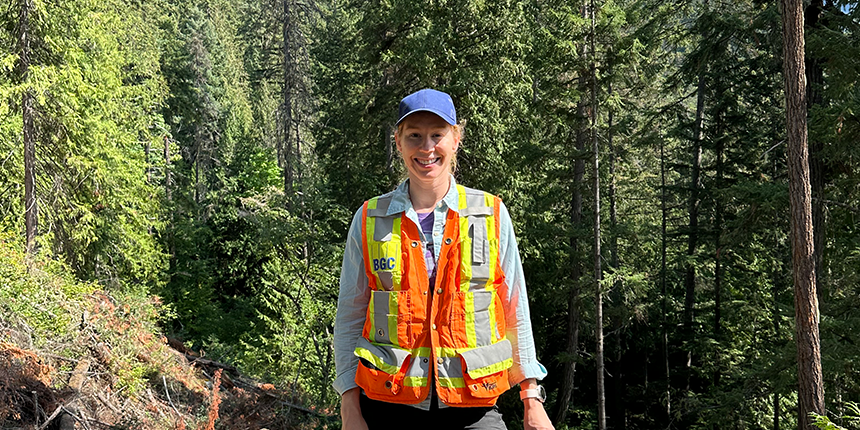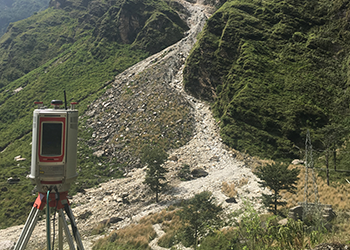
All across Canada, for communities like Lillooet Lake Estates, geotechnical and geological engineers use their knowledge of geology and water systems to understand and manage risks that come from natural hazards.

In the summer of 2013, a period of heavy rain caused over 10,000 cubic meters of a bouldery slurry, approximately 1,000 dump trucks worth of material, to flow down Catiline Creek in the subdivision of Lillooet Lake Estates, northeast of Whistler, BC, in the Squamish-Lillooet Regional District (SLRD). The debris flow overran the boat launch, pushed a pickup truck in the lake, and destroyed a rack of boats. This was not the first debris flow in Catiline Creek, nor the first to cause substantial damage, this history of hazardous occurrences prompted the Squamish-Lillooet Regional District to make a formal investigation into the likelihood of future hazardous events. Upon investigation, over 30 residents were warned that their properties were no longer safe due to the risk of dangerous landslides.
Based on this high level of risk, the District turned to engineering firms for solutions.
Water, rocks, and risk
“A debris flow is a mixture of water and rock and debris that flows downhill in a creek and can be very dangerous for individuals and buildings that are in the way,” Lauren Hutchinson explains.
Hutchinson is a senior engineer at BGC Engineering Inc. (BGC), a consulting firm headquartered in Vancouver, BC. She’s one of several engineers that tackle the geological problems that underpin communities—or that come from above, are driven by climate, or caused by natural formations, site location, or sheer chance. When the levels of risk rise above acceptable levels, geotechnical engineers will go straight to the source, examine the soil and water systems, and come up with solutions to mitigate problems before they become catastrophic.

“People live with risk,” Hutchinson asserts. Every moment from driving a car, to taking a walk, to choosing a place to live carries inherent risks. Natural hazard risks are just one piece of the puzzle, but it’s a piece that geotechnical engineers actively work to identify and manage, building safety and resiliency when communities find themselves facing unacceptable levels of danger due to natural hazards.
It may be surprising for some to learn that in Canada it is up to each individual municipality or regional authority to determine for themselves what is an acceptable or unacceptable amount of risk for different types of land use. Guidelines, such as the ones created by the District of North Vancouver in 2009 or Fraser Valley Regional District in 1991, can be used as a standard assessment to evaluate acceptable risk.
For individuals, “there's a tradeoff of the risks and benefits of being in a location,” Hutchinson explains. “When we're looking at natural hazard risk, we have to acknowledge that that's just one piece of the puzzle of how people make decisions about where they're going to live, where they're going to work, and what's going to be acceptable to them, and that what's acceptable to one individual might be different than what's acceptable to another individual. At a community scale, ensuring those who already live in areas of elevated risk from natural hazards are informed and have options to reduce risk are key.”
To tackle problems like the one Lillooet Lake Estates is experiencing, a team will begin with conceptual designs—what sort of solutions might be possible to prevent future debris flows? From there a feasible preliminary design is created. For a debris flow, solutions can involve preventing the debris material from reaching areas of concern, deflecting it in a different direction, or mitigating it as it reaches the community. BGC and the engineering firm they have partnered with, Kerr Wood Leidal (KWL), are going with the third option. They’re turning the small creek channel into a larger, deeper channel with berms designed to keep the debris safely within the channel and convey it down to Lillooet Lake without impacting the community.
Collaboration in the field
“For me,” Hutchinson says, “what makes me most excited is working directly with communities on projects that impact people's safety.” The Lillooet Lake Estates project involves not just working with a team at BGC, but partnering with KWL, and meeting with the president of the community organization involved and the project manager of the regional district to listen and understand the key concerns the community has regarding the project and the proposed solution.
“[It’s important] to contextualize the hazards and the risks into the broader needs of a community,” Hutchinson explains, “so that we are learning from community members what is most important to them, what are their needs, and setting ourselves up so that they have the greatest chance for success in meeting those needs.”
It’s equally important to make sure that time is spent on location. Despite the array of tools and data available for desktop analysis, everything from digital topography to data on stream networks and ground displacement, Hutchinson says it’s crucial for teams to go to the site and see the conditions in the field. For a geotechnical engineer, there’s no substitute for going onsite.

Hutchinson spent time in the field with the design team examining the creek at Lillooet Lake Estates, walking through the forest, planning out alignments, and comparing her physical surroundings with the design drawings and proposed modifications. Samples were collected to determine the soil conditions and pictures of the area, especially the nearby buildings, to inform construction planning and risk assessment.
Engineering resilience with finite resources
When it comes to the key to success for future geotechnical engineers, Hutchinson has an answer ready immediately. “It’s about using our resources as efficiently as possible,” she says. “How do we use the resources that we have and the understanding that we have to achieve the most risk reduction as cost effectively as possible?”
To Hutchinson, it’s a two-fold problem. Resources are not infinite, and resiliency needs to be built into new infrastructure to withstand climate change and natural hazards sustainably and effectively. Additionally, it’s important to include rural and remote communities, who may not receive as many resources as larger communities.
For example, Hutchinson states that “In BC, we're seeing a focus that's long overdue on supporting First Nations communities,” a group that has not traditionally received the support they need to effectively manage the hazards and risks in their communities.
If there are growing challenges on how to use our resources to make effective solutions to address investment of resources and climate resilient infrastructure, opportunities are growing as well. Hutchinson points to the increasing number of technologies that are available to geotechnical engineers that can acquire and process information quickly and inexpensively. She is confident that now more than ever, Canada has the technology and the knowledge to address these broad issues facing geotechnical engineers.
When asked to speak directly to future engineers, Hutchinson says that she wants them to know that engineering is so much bigger than what they experience in school. “There's a lot the variety out there and a lot of opportunities to carve out a niche that that really aligns with your interests and skill sets and passions,” she says. ““Engineering in and of itself is not the full picture.”

When she completes her work on designing a new proposal, she knows that it will fall completely flat if she can’t effectively communicate with everyone else involved—the decision makers, the funders, and the community members. The technical solution alone won’t bring a project to fruition.
Hutchinson also emphasizes the importance of teamwork. “Everything that I do is in a team of people... I work with a team of incredible people and that team changes based on what the needs of the job are. I would never be able to do the work that I do without collaborating with others.”
Valuing the skills other people bring, being open to new situations, and prioritizing the communities you serve—these are the skills that will set a geotechnical engineer on the right path.
Engineers build more than just bridges. Building Tomorrows is a series that highlights the important contributions of engineers and the many ways they help to make our world a better place.


